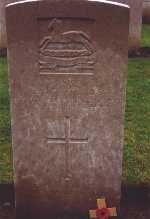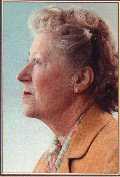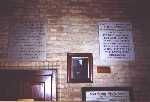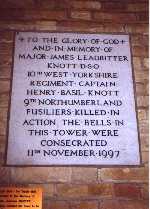SIR JAMES KNOTT
|
|
| A Talk
on The Knott Family of Close House
given by Mr John Dobson in the Knott Memorial Hall, Heddon on the
Wall, on the 24th of February 2001 |
| The Knott Family
Tree |
|
The Early Years
James Knott, was born on the 31st of January 1855, at Howdon on
Tyne. He was the eldest of ten children. His father, Matthew, was a Customs
Searcher and his mother's name was Margaret. He was educated at the Scotch School
in North Shields, which he left at the age of 14.
He had other family in the area, including an uncle who worked in
Howdon Ropeworks, and another who was the only chemist and druggist in Willington
Quay.
At the age of 14 James Knott found a job as an office boy in a shipbroker's
office on Newcastle Quayside. At the age of 19 he he started as a shipbroker,
reputedly borrowing the sum of £500, part of which he used to purchase
an old collier brig, called the "Pearl" for £186.
Sir James Knott
Sir James Knott has been described as a strong, genial, vigorous,
enthusiastic and courageous man. He was noted to have a retentive memory and
to be very observant. He was a regular attender at church and an ardent Conservative.
|
Click
the image to view a larger version
|
In the 1906 election he stood unsuccessfully as Conservative candidate
for the Tyneside Division of Northumberland. In the 1910 election he became
Conservative MP for Sunderland, but retired in December 1910 after only
a few months in office. He was a barrister, called to the Bar at Grays
Inn in 1889. He practiced for about 4 years before returning to his first
love, shipping. He was also a JP for Northumberland.
In 1914 he held a commission in the Royal Navy Reserve, but was never
called up, as his shipping expertise was so important to the war effort.
|
 |
He was a keen gardener and enjoyed deep sea and coble fishing. In
later years he enjoyed sailing his private yacht around the Mediterranean.
He was created a Baronet in 1917. His Coat of Arms bore the words
'Facta non Verba' which translates to 'Deeds not words'. He was a Knight of
Grace of the Order of St John of Jerusalem in England.
The Knott Family
In 1878 Sir James married his first wife Margaret Annie, the daughter
of Rev. Thomas Garbutt, and they had three sons:
| Thomas Garbutt Knott, born
14th of July 1879, died 1949 |
Commonwealth
War Graves Commission entry
|
| Major James Leadbitter Knott
DSO, born 2nd of December 1882, killed 1st July 1916 |
|
| Captain Henry Basil Knott,
born 5th of February 1891, killed 7th September 1915 |
|
|
Click
the images to view a larger version
|
The graves of the
two sons, buried side by side in the Reservoir Cemetery, Ypres
Apparently this is
quite unusual, as tradition dictated that British servicemen were traditionally
buried where they died, and Sir James must have exerted considerable pressure
to enable the two sons to be buried side by side.
|
 |
 |
Major
James Leadbitter Knott DSO
|
 |
Captain
Henry Basil Knott
|
At various times the family rented property in the Newcastle area
including the Manor House at Jesmond and also the shooting rights at Minsteracres
and Roddam Hall. In 1906 they moved from Jesmond to Close
House. Close House was leased from the Bewicke family, initially for a period
of five years, the lease was later extended upto the period when Sir James moved
to Jersey in 1928.
In 1925 the family moved to Samares Manor on the island of Jersey.
Lady Margaret Annie Knott died, (just after their Golden Wedding aniversary)
on board their yacht, in Cannes, on March the 8th 1929, at the age of 74. Sir
James did remarry, in 1932 at Monte Carlo, to Miss Elizabeth Chystie Gauntlett,
the 25 year old daughter of Colonel V. C. Gauntlett, and his second wife died
in Jersey, on the 23rd of November 1998.
Sir James Knott died on the 8th of June 1934, in Jersey. His funeral
was held in Jersey, on the the 12th of June, with a memorial service being held
at St Andrew's Parish church, in Heddon, on the same day.
Sir James Knott left the bulk of his £5,000,000 estate to
form the Sir James Knott trust fund. His second wife was granted an annual entitlememnt
of £15,000, until such time as she re-married, as she did in 1943, when
the sum was reduced to £10,000 per annum. A question was asked in the
House of Commons, on the 27th of June 1934, concerning the estate of Sir James
Knott, and the fact that it avoided paying £2,500,000 in death duties,
as he was no longer a UK resident.
Sir Garbutt Knott, who inherited his father's title in 1934, lived
at a property called Courtlands, in Devon. Here he raised Jersey cows and was
a keen pigeon fancier. Although he was married twice he died without issue.
Samarès Manor
|
Lady Elizabeth Knott
- click the images to view a larger version of the picture
|
 |
Samarès Manor is located on the island of Jersey and dates back
to at least the 12 century. Sir James purchased Samares Manor in 1924
and retired there. He was responsible for much refurbishment of the property,
reputedly spending around £50,000 on the gardens alone, between
1925 and his death in 1934.
Samarès Manor, which is open to the public, belongs to the Obbard
family, after Lady Elizabeth Knott married Commander Edward Owen Obbard
D.S.O., G.M., RN, in 1943.
|
 |
The Shipping
Business
From the single collier brig, purchased in 1869, James Knott built
up to over 20 collier brigs, all plying their trade along the east coast, managed
from an office in Milburn House. James Knott has vision and was quick to see
the possibilities of changing technical developments in the shipping industry,
in particular the value of steam.
In 1881 he purchased his first steam ship the "Saxon Prince"
which was 832 tons gross, 530 tons net. By 1883 he added a further 8 steam ships
and by 1886 had a total of 17, and purchased his first tanker. In 1895 he set
up the Prince Line Ltd, which he went on to build up to be the third largest
privately owned shipping line in the world. In 1897 he formed the Prince Steam
Shipping Association. By 1898 he had a fleet of 35 vessels and was trading all
over the world. This increased to 45 vessels by 1914.
Throughout the time that he was in the shipping business Sir James
had 32 ships built in Tyne and Wear shipyards, primarily by Short Bros. All
the ships carried the following warning inscribed on their bridges.
|
'All
accidents are the Result of Carelessness'
|
In 1916 the Prince Line was sold to the Furness Withy Co for £3,000,000.
In all there were four ships with the name of "Saxon Princes":
| 1. |
The
original was commissioned in 1881 and was launched in March at Swan Hunters
yard in Wallsend. It was sold in 1885 to Christian Salvesen & Co Ltd
at Leith and was renamed Glitra. It was the first ship to be sunk by submarine
(U17) in the First World War, off the coast of Norway on the 20th October
1914 |
| 2. |
The
second cost £35, 893 when built by Shorts in July 1899. She was captured
by the German raider Moewe in February 1916 and sunk by bombs. |
| 3. |
The
third was owned by the Prince Line from 1917 to 1928. She was torpedoed
in 1942. |
| 4. |
The
fourth was owned by the Prince Line from 1971 to 1975 and was still in service
in 1988. |
Sir James had other business interests. In 1899 he purchased Togston
Colliery and formed the Acklington Coal Co Ltd, which was later taken over by
Broomhill Colliery Ltd. He also had an interest in an anthracite mine called
the South Wales Primrose Coal Co.
In 1918 Sir James bought property in Heddon village from the trustees
of the Clayton family. In 1924 they sold 32 lots of property in Heddon, including
East Town Farm, Clayton Terrace, Blue Row, Garden House, the Blacksmiths shop
and the Three Tuns Inn. (Sale catalogue)
Gifts and Donations
Sir James Knott
|
The Knott family were great benefactors to the north east and in particular
to the village of Heddon on the Wall, where they had a major influence
on the village, as we know it today.
The Knott family were responsible for creating the Memorial
Park, in Heddon, opened in 1925, in memory of the two sons who
were both killed in action in the Great War. Major James Leadbitter Knott
D.S.O. of the West Yorkshire Regiment and Captain Henry Basil Knott of
the Northumberland Fusiliers.
|
Lady Margaret Knott
|
 |
 |
The Knott Family also gave to the village of Heddon, the Knott
Memorial Hall, erected in 1936, in memory of Sir James and Lady Margaret
Annie Knott, by their son Sir Garbutt Knott. The Knott family have also been
responsible for many other charitable works in the north east including the
following:
|
»
|
James Knott Youth Centre, which opened in North Shield in 1938, provided
the site and a generous contribution to the building cost |
|
»
|
Donation
to the Northern Counties Orphanage |
|
»
|
Donating
the section of the Roman Wall in Heddon to the Society of Antiquaries of
Newcastle |
|
»
|
Nursery
School in North Shields |
|
»
|
Convalescent
hospital for officers in Torquay during World War 1 |
|
»
|
Provision
of 'Merci Beaucoup' cottage, for the use of wives and mothers visiting wounded
soldiers, convalescing at Holyn Hall. |
|
»
|
RNLI
Lifeboat, The Sir James Knott, Cullercoats |
|
»
|
An
Interest in Tynemouth Victoria Jubilee Infirmary |
|
»
|
Knott
Flats, Tynemouth |
|
»
|
Donation
to Haig Homes to build about 25 houses for Newcastle ex-servicemen and their
families |
|
»
|
Tower
of St. George's Anglican Church at Ypres (Son's graves are within 200 yards
of the church) |
|
»
|
Gifts
to Newcastle University |
|
»
|
Knott
Memorial trust for the relief of hardship of men who served in their son's
regiments |
|
»
|
St.
James and St. Basil church in Fenham (1931), including the vicarage, church
hall and a sunken garden. |
| Click
the images to see a larger version |
St.
James and St. Basil Church in Fenham
|
Church
Hall and Gardens.
|
 |
 |
 |
It has been suggested than when the plans were being made
to erect the Knott Memorial Hall in Heddon, three alternative sets of plans
were drawn up. One of the sets not used, in Heddon, was used to build the
Church Hall in Fenham
Sir James was responsible for establishing the Sir James Knott Trust,
which is responsible for making payment to registered charities currently
around £1 million pounds, each year. The trust was originally administered
from Jersey but has more recently moved to Newcastle.
Today the Sir James Knott Trust owns the College valley, a beautiful
and remote area of north Northumberland, this estate also includes the land
on which the Chillingham herd of wild white cattle are kept.














